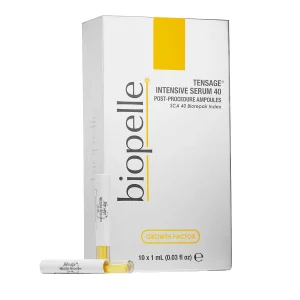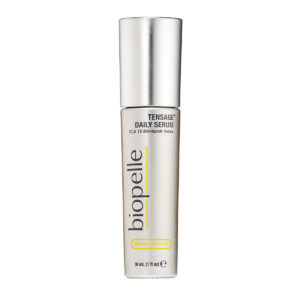Aging is a complicated process that each of us experiences in a unique way, especially when it comes to visible aspects of aging like our hair or skin. Our genetics play an important role in our skin’s appearance. If both of your parents have maintained firm, smooth skin, chances are good that you will too. This is part of the intrinsic aspect of aging, which combines with cell function and hormonal changes to affect the skin’s appearance. Research suggests our genes account for a portion of our skin’s overall aging process.
What about the remaining 80% or more of our face’s aging process? It’s up to us. How well do you take care of your skin? Do you keep it moisturized and protected from harmful UV rays? Do you nurture it with a healthy, balanced diet and plenty of water? If not, chances are good that you will notice the impact of these lifestyle choices as you get older, and extrinsic aging takes a toll on your facial skin.
What is Intrinsic Aging?
Intrinsic aging is the natural biological process of aging that we all will experience. Beginning in our twenties and continuing for the remainder of our lives, intrinsic aging gradually reduces our skin’s ability to stay elastic and repair itself. What this means in terms of the mirror is your skin may slowly lose its ability to recover from hyperpigmentation and eventually you’ll be more susceptible to changes in skin texture and hydration, as well as fine lines and wrinkles. The pace and severity of intrinsic aging is determined by our genes and cellular function and can also be hastened by free radicals. There are some steps we can take to slow down intrinsic aging, but time and genetics will inevitably take a toll on our skin.
Slower production of stem cells, estrogen loss, reduced collagen and elastin, and deteriorating facial tissues are all part of intrinsic aging.
What is Extrinsic Aging?
Extrinsic aging describes the impact our environment and other preventable factors have on our skin’s aging process. Sun exposure, smoking, hydration, diet, skin care products and more contribute to extrinsic aging. Discoloration, wrinkles and thinning facial skin are a few signs that extrinsic aging is occurring.
Many aspects of extrinsic aging are largely controllable. For example, using sunscreen and not smoking are two steps we can all take to slow signs of extrinsic aging.
Slowing Skin Aging
Wherever your skin is along its natural, intrinsic aging process, there are steps you can take right now to slow visible signs of age due to extrinsic aging. Try some of these steps to protect your skin from developing wrinkles, sagging and sun spots:
- Apply broad-spectrum sunscreen to your face before you leave the house to protect against the sun’s damaging UVA and UVB rays.
- Stop smoking – or don’t start. Smoking damages facial skin in several ways. Nicotine in cigarettes constricts the blood vessels, thereby depriving the skin of oxygen and nutrients. Other chemicals in cigarettes lead to a dull, yellow complexion. Squinting the eyes and pursing the lips while smoking leads to more wrinkles in those areas of the face.
- Eat plenty of fresh fruits and vegetables so your skin can benefit from their antioxidants. These molecules fight free radicals, which have been linked not only to aging skin but also heart disease, cancer and other major health conditions.
- Limit alcohol consumption. Alcohol has a dehydrating effect on the body
- Get regular exercise. Exercise increases circulation, which brings more nutrients and oxygen to the skin while flushing away waste. Exercise also reduces stress and can reduce stress-related skin conditions like eczema and acne.
- It can be easier said than done, but getting a good night’s sleep is imperative to your body’s ability to repair itself. Your skin does the hard work of healing at night, so good rest is an important part of a complete skin care routine.
Also, it’s important to start a skincare routine that includes a gentle daily cleanser, regular exfoliation and a moisturizer that fits your age and skin type. Many skincare products address the extrinsic signs of aging, like fine lines and wrinkles. However…
Addressing Intrinsic Aging

A variety of Biopelle products address intrinsic aging, such as decreased cellular turnover, slowing stem cell production and collagen loss, as well signs of extrinsic aging. For example, Biopelle’s Tensage Growth Stem Cell anti-aging skincare products use the power of retinol, emollients and CellPro™ Technology to improve skin from the inside out. Tensage Stem Cell Cream is designed to help reduce fine lines and wrinkles, promote a more even skin tone and promote fuller, plumper skin through increased collagen production.
Why Choose Biopelle on Your Skin Aging Journey?
Biopelle is serious about the science of skincare. We are proud to offer effective anti-aging skincare solutions that are never tested on animals. We source ingredients for our Tensage products from C. aspersa snails in a responsible and cruelty-free way. All Biopelle products are also gluten-free, and most are paraben-free.
For skincare products that effectively combat the effects of intrinsic and extrinsic aging, rely on Biopelle. More than 1,500 physician’s offices and med spas trust us to provide the best possible products for their patients and guests. Browse our full list of anti-aging skincare products to find just the right solutions for your skin’s specific needs.



